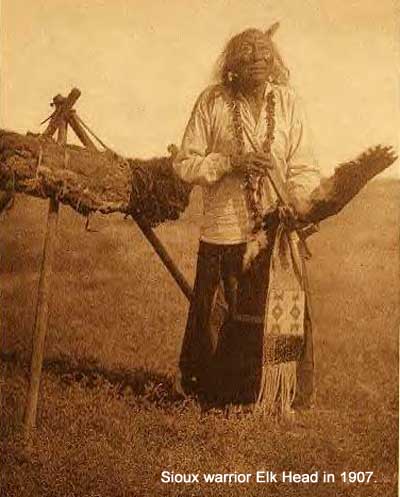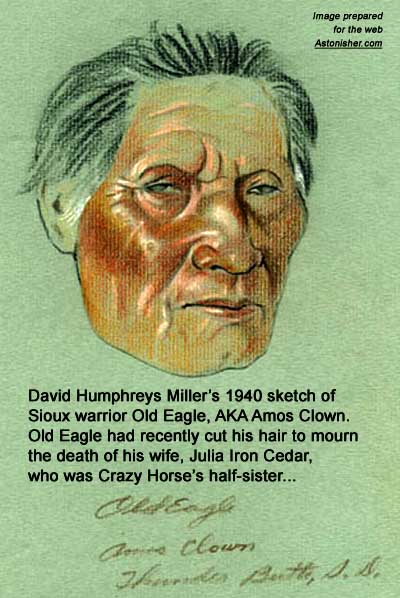
This is a FREE EXCERPT from
Bruce Brown's 100 Voices...
Elk Head's Story of the Battle
A Brule Sioux's account of the Battle of the Rosebud
|
As told to William J. Bordeaux, who also translated.
|
Note |
ELK HEAD'S STORY OF THE BATTLE
 AS TO THE incidents that took place at the upper end of the village, the best account that I have, was given to me by Elk Head and others who have verified his version. "Our two separate bands composed of Hunkpahpahs and Minnikanwojues met and engaged a body of troops who had arrived within sight of the village without being detected, but before they had a chance to advance in formation we broke up the attack and they were driven back to a timbered hillside where they dismounted to seek cover behind trees and bouldered rocks. We kept them busy dodging our bullets and, arrows.A second detachment, some of whom were mounted on white horses, did succeed in breaking through to us and crossed the river but we threw them back and several of them were killed and wounded. [Note: I used to think that Elk Head was describing Custer here, but I've changed my mind. In truth, I really don't know what he's saying -- that Reno attacked in three waves, only one of which got across the river?] A second attempt to cross the river that lay between us was even less successful for they not only lost more men but they were forced to retreat in desperate disorder; for the remainder of the battle they remained hidden behind a thick grove well screened with heavy brush. We could not at first understand why they were making such desperate efforts to break through our defense until the news of the total destruction of Custer's command was relayed to us by a group of youngsters who had ridden over from the scene of the conflict. Their motive then was plain for they had been hastening to the aid of Custer who had planned to attack the lower end or the village." AS TO THE incidents that took place at the upper end of the village, the best account that I have, was given to me by Elk Head and others who have verified his version. "Our two separate bands composed of Hunkpahpahs and Minnikanwojues met and engaged a body of troops who had arrived within sight of the village without being detected, but before they had a chance to advance in formation we broke up the attack and they were driven back to a timbered hillside where they dismounted to seek cover behind trees and bouldered rocks. We kept them busy dodging our bullets and, arrows.A second detachment, some of whom were mounted on white horses, did succeed in breaking through to us and crossed the river but we threw them back and several of them were killed and wounded. [Note: I used to think that Elk Head was describing Custer here, but I've changed my mind. In truth, I really don't know what he's saying -- that Reno attacked in three waves, only one of which got across the river?] A second attempt to cross the river that lay between us was even less successful for they not only lost more men but they were forced to retreat in desperate disorder; for the remainder of the battle they remained hidden behind a thick grove well screened with heavy brush. We could not at first understand why they were making such desperate efforts to break through our defense until the news of the total destruction of Custer's command was relayed to us by a group of youngsters who had ridden over from the scene of the conflict. Their motive then was plain for they had been hastening to the aid of Custer who had planned to attack the lower end or the village."
Custer's Conqueror by William J. Bordeaux, Smith & Company 1944 p 59
Elk Head had two sons, Young Elk Head and Two Runs. Although they were too young to fight, they too contributed to the Little Bighorn story. Here is their account, as told to David Humphreys Miller.
Born in 1884, William J. Bordeaux was the son of a white trader and a Brule Sioux mother, and a registered member of the Brule band of the Teton Sioux. He was not an eye-witness to the events he writes about, but like 100 Voices' other Indian chroniclers (Ohiyesa, John Stands In Timber, Bird Horse and Pretty Shield), Bordeaux had fluent, native access to some important participants whose information is not avialble elsewhere.
 Bordeaux's writing is extremely frustrating to many students of the American wars with the Sioux and Cheyenne, for while his narrative is frequently garbled, he is also the only source for Sioux warriors Elk Head and Foolish Elk's important eye-witness account of the Battle of the Little Bighorn. Bordeaux's writing is extremely frustrating to many students of the American wars with the Sioux and Cheyenne, for while his narrative is frequently garbled, he is also the only source for Sioux warriors Elk Head and Foolish Elk's important eye-witness account of the Battle of the Little Bighorn.
Furthermore, Bordeaux interviewed Crazy Horse's sister, Julia Iron Cedar or Mrs. Amos Clown, which makes his comments on Crazy Horse particularly important. For instance, Bordeaux records Crazy Horse's prediction that the Americans were lying and wouldn't honor the commitments they made to the Sioux in the treaty of 1868, which was true as it turned out.
Improbably, William J. Bordeaux was also one of the most astute Indian observers of Crazy Horse's military innovations, describing how Crazy Horse very cleverly attacked a line of Custer's men head on and "slashed at them from both sides" at the Little Bighorn, thereby minimizing the Bluecoats' defensive firepower, and how at the Rosebud, he attacked Crook in encircling waves, a technique Crazy Horse developed to isolate and destroy portions of the American force piecemeal. See Sioux & Cheyenne Military Tactics during the American Wars of Imperial Conquest on the High Plains for more info.
Similarly, Bordeaux's tantilizingly brief picture of Crazy Horse in action on the Powder River -- where he tersely yet wryly asks his sub-commanders, "how about it?" -- provides an almost Socratic picture of Crazy Horse in the commander's role. It isn't hard to imagine his eager young accolytes like Good Weasel and Kicking Bear and Little Big Man vying to provide the smartest -- effectively lethal -- answer to their mentor.
© Copyright 1973 - 2020 by Bruce Brown and BF Communications Inc.
Astonisher, Astonisher.com, Conversations With Crazy Horse, 100 Voices, Who Killed Custer?, The Winter Count of Crazy Horse's Life, and Mysteries of the Little Bighorn are trademarks of BF Communications Inc.
BF Communications Inc.
P.O. Box 393
Sumas, WA 98295
(360) 927-3234
Website by Running Dog  |
|





|




 AS TO THE incidents that took place at the upper end of the village, the best account that I have, was given to me by Elk Head and others who have verified his version. "Our two separate bands composed of Hunkpahpahs and Minnikanwojues met and engaged a body of troops who had arrived within sight of the village without being detected, but before they had a chance to advance in formation we broke up the attack and they were driven back to a timbered hillside where they dismounted to seek cover behind trees and bouldered rocks. We kept them busy dodging our bullets and, arrows.
AS TO THE incidents that took place at the upper end of the village, the best account that I have, was given to me by Elk Head and others who have verified his version. "Our two separate bands composed of Hunkpahpahs and Minnikanwojues met and engaged a body of troops who had arrived within sight of the village without being detected, but before they had a chance to advance in formation we broke up the attack and they were driven back to a timbered hillside where they dismounted to seek cover behind trees and bouldered rocks. We kept them busy dodging our bullets and, arrows.








